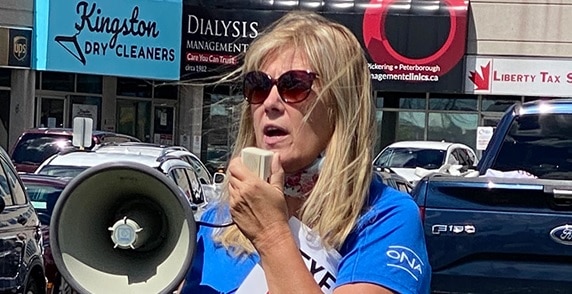Over 4-in-5 Hamilton OR nurses alarmed ‘unregulated’ workers assisting in surgeries at 3 area hospitals
Published September 2, 2022 at 11:32 am

Some 84 per cent of operating room nurses at three Hamilton Health Sciences sites are calling for an ‘immediate reversal’ of a move to have operating room assistants take part on surgeries.
Ontario Nurses’ Association provincial president Cathryn Hoy says that a letter to HHS CEO Rob MacIsaac and the board of directors was hand-delivered to the top executive on Thursday. It was signed by nurses who work at Hamilton General, McMaster and Juravinski sites. Nurses, who were hailed as frontline health-care heroes in Year 1 of the COVID-19 pandemic in 2020, are concerned that the move puts people underdoing surgery at risk for complications and errors.
“A patient’s condition can be unpredictable when in surgery, and it can rapidly decline when patients lose their ability to breathe, have unexpected bleeding and other complications,” Hoy says in a release from ONA. “Scrub nurses, who have a diploma or degree in nursing plus specialized credentials in perioperative nursing, are highly trained professionals who can handle emergency situations in surgery. ORAs are not able to respond to critical issues that arise.”
On Thursday, HHS acknowledged it is facing “healthcare worker shortages.” Surgical and procedural activity is at 75 per cent of pre-pandemic volumes, which echoes the “long and lasting COVID hangover” that MacIsaac, back in February, said is in store for Hamilton.
Ontario has a pandemic backlog of some 1 million surgeries. The budget that the Premier Doug Ford-led Ontario PC Party government folded into their re-election platform, but did not actually pass until August, was to include a $300-million boost for delays in surgery and diagnostic imaging.
The nurses’ union, which represents 68,000 registered nurses and health-care professionals, as well as 18,000 nursing student affiliates, refer to operation room assistants as “unregulated,” and using them in surgeries is not the way to go.
Hoy: ‘Increased risk of errors and medication mistakes’
A release states that becoming an ORA involves about 22 hours of virtual training, two labs and two weeks of practical experience. All registered nurses in Ontario must have a degree, either through a university or collaborative college-university program.
“An operating room is not a place to cut corners and make cost savings,” Hoy says. “Patients undergo surgery to deal with very serious life-threatening diseases and urgent-care needs — you need to have a health-care professional in a scrub nurse role that does more than pass instruments.
“This plan could needlessly increase the number of surgeries because there is an increased risk of errors and medication mistakes,” Hoy adds. “Hiring ORAs does not support patient safety.”
Registered nurses who are employed in Ontario hospital, in terms of real dollars, have had government-imposed pay decreases for over 3½ years. In 2019, Bill 124 legislation passed by the Ford-led Ontario PCs included the majority-female nursing field among provincial employees whose annual pay raises are capped at 1 per cent. Inflation was 2 per cent then, and is currently 7.6%.
The ONA says operating room nurses at the three hospitals within HHS brought their concern to managers as soon as the plan was announced, but it went ahead.
The release from ONA did not make any reference to whether HHS is using agency nurses, who are employed by private companies. Some short-staffed hospitals in Ontario have been farming out staffing to private companies.
Agency nurses, so-called, have a much higher wage than a hospital nurses, but with private companies as a middleman, the cost to the health sector (and taxpayers) is several times larger than it is with the latter.
insauga's Editorial Standards and Policies advertising





